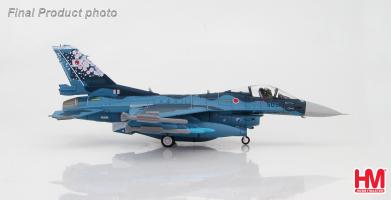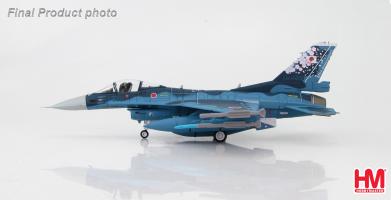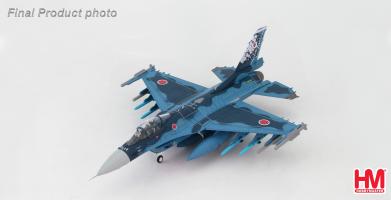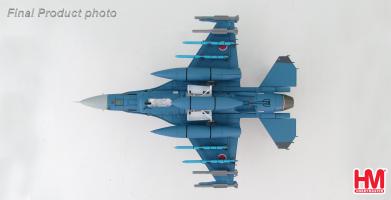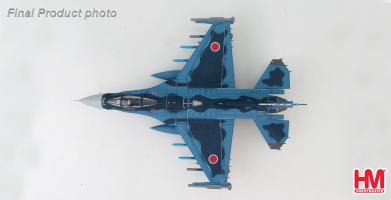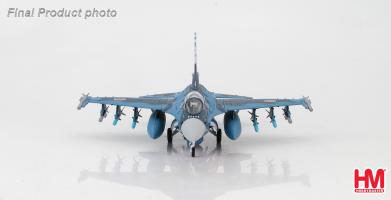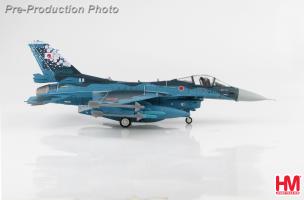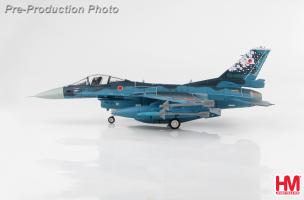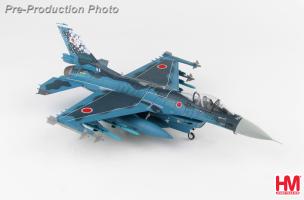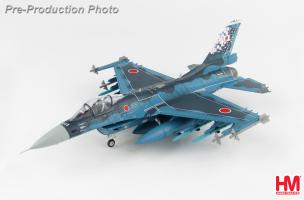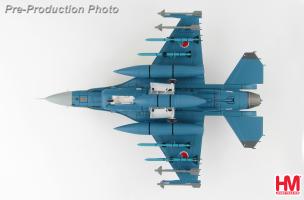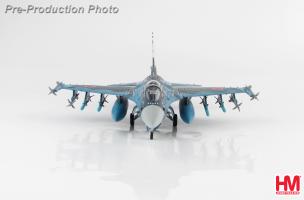Hobby Master Archive
Air Power Jets 1/72
F-2
F-2A JASDF "60th Anniversary" scheme
Hobby Master 1/72 Air Power Series HA2712 Mitsubishi F-2A 03-8509 “60th Anniversary” scheme
Die-cast metal. Superb detailing in 1/72 scale. Pre-painted with pad applied markings. Fully assembled. Weapons that are not permanently attached. Includes AAM-5 missiles Comes with crew figures Display stand included. Option to display model with wheels up or down. Minimum use of plastic.
Specifications Mitsubishi F-2A Nickname - Viper Zero Designation - Single-seat Multi-role fighter Crew - 1 (or 2 for the F-2B) Performance Powerplant: (1) General Electric F110-GE-129 turbofan Dry thrust - 76 kN (17,000 lbf) Thrust with afterburner - 131 kN (29,500 lbf) Maximum speed - Mach 2.0 Range - 520 miles (834 km) on anti-ship mission Service ceiling - 59,000 ft (18,000 m) Dimensions Length - 50 ft 11 in (15.52 m) Wingspan - 36 ft 6 in (11.13 m) Height - 15 ft 5 in (4.69 m) Wing area - 375 ft² (34.84 m²) Weights Empty - 21,000 lb (9,527 kg) Loaded - 33,000 lb (15,000 kg) Max takeoff - 48,700 lb (22,100 kg) Armament (1) 20 mm JM61A1 cannon Capable of carrying up to 17,820 lb (8,085 kg) weapon load on 11 hard points. They are located - #1 and #11 at the wing tips, #2-5 and #7-10 under the wings, and #6 under the fuselage. Possible Weapons Air-to-air - AIM-9 Sidewinder, AIM-7 Sparrow, Mitsubishi AAM-3, Mitsubishi AAM-4 Air-to-ground - ASM-1 and ASM-2 anti-ship missiles. Various free-fall bombs with GCS-1 IIR seeker heads, Mk 82 and JM177 bombs, CBU-87, JDAM and JLAU-3/A or RL-4 rocket pods. Others - J/AAQ-2 FLIR Avionics Mitsubishi Active Electronically Scanned Array radar system including J/APG-1. Some differences between the F-2A and the F-16 F-2A has a 25% larger wing area. F-2A is manufactured using composite materials to reduce overall weight and radar signature. F-2A is longer and wider nose to accommodate phased-array radar. F-2A has a larger tail-plane. F-2A has a larger air intake. F-2A has a three-piece cockpit canopy.
F-2A is equipped with a drogue parachute.
During the 1980s General Dynamics, the developer of the F-16, proposed another version of the F-16 called the F-16 Agile Falcon. The US military opted not to get involved because they were busy upgrading their present fleet as well as developing the new F- 22/JSF. Japan had decided to purchase the F-16 to replace its aging F-1 aircraft but then decided to develop the F-16 Agile Falcon concept. The new aircraft for the JASDF (Japan Air Self Defense Force) would be the F-2 and manufactured with a 60/40 split between Mitsubishi Heavy Industries and Lockheed Martin. Lockheed Martin bought General Dynamics in 1993. Production started in 1996 with the first aircraft being delivered in 2000. 94 of the F-2 aircraft are scheduled to be manufactured. It might look like an F-16 but the Mitsubishi F-2 is a completely new fighter. The general shape may say F-16 and a few things that the F-2 and the F-16 have common are the engine, landing gear, air intake door and the 20 mm gun. But the F-2 has a longer and wider nose to accommodate phased-array radar with 25% larger wing. It is made from a composite material to reduce weight and radar signature, a larger tail plane and larger air intake. The pilot canopy is a stronger three-piece construction. The F-2 is equipped with a drogue chute just like the NATO version of the F-16. The single seat fighter is the F-2A while the two seat version is a trainer that is fully Combat capable.
Mitsubishi F-2A 03-8509 c/n 1009 code 509 was manufactured in 2000 and delivered for active service on December 22, 2000. In September 2014 while with the JASDF 3rd Squadron at Misawa Air Base this F-2A was given a special paint scheme to honor the 60th Anniversary of the JASDF. The design was comprised of a 60th Anniversary badge located on the sides of the air-intake, while the vertical tail displayed the national flag of Japan with cherry blossoms and a diagonal “60th Anniversary” written next to it.
| Added to archive | 2015-11-19 |
| Last modified | 2015-11-19 |
| Leaflet | 2015-09-01 September 2015 |
